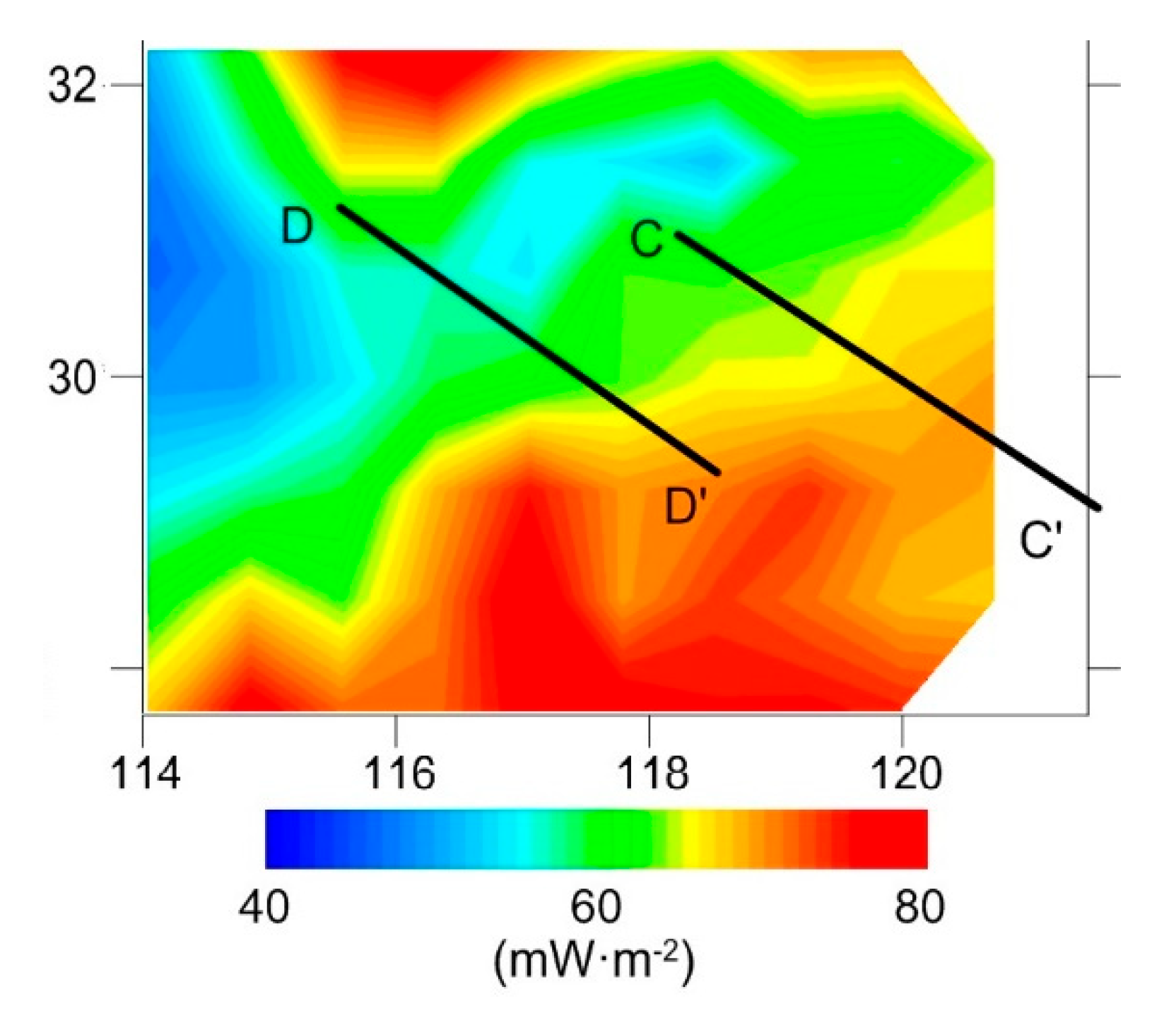Electrical Imaging Across Eastern South China: New Insights into the Intracontinental Tectonic Process During Mesozoic
Abstract
1. Introduction
2. Geologic Setting
3. Data Processing and Analysis
3.1. Data Acquisition and Processing
3.2. Data Analysis
- (1)
- Phase tensor analysis
- (2)
- Pseudo-sections analysis
4. Inversion and Interpretation
4.1. Inversion
4.2. Electrical Models Interpretation
5. Discussion
5.1. Lithospheric Structure in Eastern SCB
5.2. The Mesozoic Tectonic Process in Eastern SCB
6. Conclusions
Author Contributions
Funding
Data Availability Statement
Conflicts of Interest
References
- Hu, R.Z.; Mao, J.W.; Hua, R.M.; Fan, W.M. Intracontinental Mineralization in South China; Science Press: Beijing, China, 2015. (In Chinese) [Google Scholar]
- Wang, X.-L.; Zhou, J.-C.; Griffin, W.; Wang, R.-C.; Qiu, J.-S.; O’Reilly, S.; Xu, X.; Liu, X.-M.; Zhang, G.-L. Detrital zircon geochronology of Precambrian basement sequences in the Jiangnan orogen: Dating the assembly of the Yangtze and Cathaysia Blocks. Precambrian Res. 2007, 159, 117–131. [Google Scholar] [CrossRef]
- Zhai, M.; Zhou, Y. General Precambrian Geology in China. In Precambrian Geology of China; Springer: Berlin/Heidelberg, Germany, 2015. [Google Scholar]
- Cawood, P.A.; Wang, Y.; Xu, Y.; Zhao, G. Locating South China in Rodinia and Gondwana: A fragment of greater India lithosphere? Geology 2013, 41, 903–906. [Google Scholar] [CrossRef]
- Hacker, B.R.; Wallis, S.R.; Ratschbacher, L.; Grove, M.; Gehrels, G. High temperature geochronology constraints on the tectonic history and architecture of the ultrahigh-pressure Dabie–Sulu Orogen. Tectonics 2006, 25, TC5006. [Google Scholar] [CrossRef]
- Yang, W.; Yu, C. Kinetics and dynamics of development of the Dabie-Sulu UHPM terranes based on geophysical evidences. Chin. J. Geophys. 2001, 44, 340–356, (In Chinese with English Abstract). [Google Scholar]
- Jiang, G.; Zhang, G.; Lü, Q.; Shi, D.; Xu, Y. 3-D velocity model beneath the Middle–Lower Yangtze River and its implication to the deep geodynamics. Tectonophysics 2013, 606, 36–47. [Google Scholar] [CrossRef]
- Pan, Y.; Dong, P. The Lower Changjiang (Yangzi/Yangtze River) metallogenic belt, east central China: Intrusion- and wall rock-hosted Cu–Fe–Au, Mo, Zn, Pb, Ag deposits. Ore Geol. Rev. 1999, 15, 177–242. [Google Scholar] [CrossRef]
- Lü, Q.T.; Meng, G.X.; Zhang, K.; Liu, Z.D.; Yan, J.Y.; Shi, D.N.; Han, J.G.; Gong, X.J. The lithospheric architecture of the Lower Yangtze Metallogenic Belt, East China: Insights into an extensive Fe–Cu mineral system. Ore Geol. Rev. 2021, 132, 103989. [Google Scholar] [CrossRef]
- Zhou, X.M.; Sun, T.; Shen, W.Z.; Shu, L.S.; Niu, Y.L. Petrogenesis of Mesozoic granitoids and volcanic rocks in South China: A response to tectonic evolution. Episodes 2006, 29, 26–33. [Google Scholar] [CrossRef] [PubMed]
- Zhou, T.F.; Wang, S.W.; Yuan, F.; Fan, Y.; Zhang, D.Y.; Chang, Y.F.; White, N.C. Magmatism and related mineralization of the intracontinental porphyry deposits in the Middle-Lower Yangtze River Valley Matellogenic Belt. Acta Petrol. Sin. 2016, 32, 271–288. [Google Scholar]
- Pirajno, F. The Geology and Tectonic Settings of China’s Mineral Deposits; Springer: New York, NY, USA, 2013. [Google Scholar]
- Ouyang, L.B.; Li, H.Y.; Lü, Q.T.; Yang, Y.J.; Li, X.F.; Jiang, G.M.; Zhang, G.; Shi, D.; Zheng, D.; Sun, S.; et al. Crustal and uppermost mantle velocity structure and its relationship with the formation of ore districts in the Middle–Lower Yangtze River region. Earth Planet. Sci. Lett. 2014, 408, 378–389. [Google Scholar] [CrossRef]
- Dalhkamp, F.J. Uranium Deposits of the World; Springer: Berlin/Heidelberg, Germany, 2009; Volume 4. [Google Scholar]
- Mao, J.R.; Li, Z.L.; Ye, H.M. Mesozoic tectono-magmatic activities in South China: Retrospect and prospect. Sci. China Earth Sci. 2014, 57, 2853–2877. [Google Scholar] [CrossRef]
- Zhang, K.; Lü, Q.T.; Lan, X.Y.; Guo, D.; Wang, Q.N.; Yan, J.Y.; Zhao, J.H. Magnetotelluric evidence for crustal decoupling: Insights into tectonic controls on the magmatic mineral system in the Nanling–Xuancheng area, SE China. Ore Geol. Rev. 2021, 131, 104045. [Google Scholar] [CrossRef]
- Hou, Z.Q.; Pan, X.F.; Yang, Z.M.; Qu, X.M. Porphyry Cu–(Mo–Au) deposits no related to oceanic-slab subduction: Examples from Chinese porphyry deposits in continental settings. Geoscience 2007, 21, 332–351. [Google Scholar]
- Hsü, K.J.; Li, J.L.; Chen, H.H. Mesozoic overthrust tectonics in South China. Geology 1998, 16, 418–421. [Google Scholar] [CrossRef]
- Gilder, S.A.; Gill, J.; Coe, R.S. Isotopic and palaeomagnetic constraints on the Mesozoic tectonic evolution of south China. J. Geophys. Res. 1996, 101, 16137–16154. [Google Scholar] [CrossRef]
- Li, X.H. Cretaceous magmatism and lithospheric extension in southeast China. J. Asian Earth Sci. 2000, 18, 293–305. [Google Scholar] [CrossRef]
- Wang, Y.J.; Fan, W.M.; Zhang, G.W.; Zhang, Y.Z. Phanerozoic tectonics of the South China Block: Key observations and controversies. Gondwana Res. 2013, 23, 1273–1305. [Google Scholar] [CrossRef]
- Ling, M.X.; Wang, F.Y.; Ding, X. Cretaceous ridge subduction along the Lower Yangtze River Belt, Eastern China. Econ. Geol. 2009, 104, 303–321. [Google Scholar] [CrossRef]
- Wannamaker, P.; Hill, G.; Stodt, J.; Maris, V.; Ogawa, Y.; Selway, K.; Boren, G.; Bertrand, E.; Uhlmann, D.; Ayling, B.; et al. Uplift of the central transantarctic mountains. Nat. Commun. 2017, 8, 1588. [Google Scholar] [CrossRef]
- Lü, Q.T.; Liu, Z.D.; Dong, S.W.; Yan, J.Y.; Zhang, Y.Q. The nature of Yangtze River deep fault zone: Evidence for deep seismic data. Chin. J. Geophys. 2015, 58, 4344–4359, (In Chinese with English Abstract). [Google Scholar]
- Swell, R.J.; Davis, D.W.; Campbell, S.D.G. High precision U-Pb zircon ages for Mesozoic igneous rocks from Hong Kong. J. Asian Earth Sci. 2012, 43, 164–175. [Google Scholar] [CrossRef]
- Ye, H.M.; Mao, J.R.; Zhao, X.L. Revisiting to the Early Yanshanian (190~170 Ma) igneous activity in Nanling Mountains, South China: Geochemistry and geodynamic implications. J. Asian. Earth Sci. 2013, 72, 108–117. [Google Scholar] [CrossRef]
- Zhang, K.; Lü, Q.T.; Yan, J.Y.; Shao, L.S.; Guo, D. The subduction and continental collision of the North China and Yangtze Blocks: Magnetotelluric evidence from the Susong-Anqing section of Western Anhui, China. Geophys. J. Int. 2019, 216, 2114–2128. [Google Scholar] [CrossRef]
- Zhang, K.; Yan, J.Y.; Lü, Q.T.; Wei, W.B.; Wang, H.F.; Zhang, Y.W. Correction of magnetotelluric static shift by analysis of 3D forward modeling and measured test data. Explor. Geophys. 2016, 47, 100–107. [Google Scholar] [CrossRef]
- Caldwell, T.G.; Bibby, H.M.; Brown, C. The magnetotelluric phase tensor. Geophys. J. Int. 2004, 158, 457–469. [Google Scholar] [CrossRef]
- Rodi, W.; Mackie, R.L. Nonlinear conjugate gradients algorithm for 2-D magnetotelluric inversion. Geophysics 2001, 61, 174–187. [Google Scholar] [CrossRef]
- Xu, X.; O’Reilly, S.Y.; Griffin, W.L.; Zhou, X.M. Enrichment of upper mantle peridotite: Petrological, trace element and isotopic evidence in xenoliths from SE China. Chem. Geol. 2003, 198, 163–188. [Google Scholar] [CrossRef]
- Zheng, J.P.; O’Reilly, S.Y.; Griffin, W.L.; Zhang, M.; Lu, F.X.; Liu, G.L. Nature and evolution of Mesozoic–Cenozoic lithospheric mantle beneath the Cathaysia block, SE China. Lithos 2004, 74, 41–65. [Google Scholar] [CrossRef]
- Yao, Y.; Xu, X.; Griffin, W.L.; O’Reilly, S.Y.; Xia, Q.K. H2O contents and their modification in the Cenozoic subcontinental lithospheric mantle beneath the Cathaysia block, SE China. Lithos 2011, 126, 182–197. [Google Scholar] [CrossRef]
- Zheng, Y.F. Metamorphic chemical geodynamics in continental subduction zones. Chem. Geol. 2012, 328, 5–48. [Google Scholar] [CrossRef]
- Xue, H.M.; Dong, S.W.; Ma, F.I. Zircon U-Pb SHRMP ages of sub-volcanic bodies related with porphyritic Fe-deposits on the Luzong and Ningwu basins Middle and Lower Yangtze River Reaches, Central China. Acta Petrol. Sin. 2010, 26, 2653–2664, (In Chinese with English Abstract). [Google Scholar]
- Uno, K.; Huang, B. Constraints on the Jurassic swing of the apparent polar wander path for the North China Block. Geophys. J. Int. 2003, 154, 801–810. [Google Scholar] [CrossRef]
- Xu, Y.; Yang, B.; Zhang, S. Magnetotelluric Imaging of a Fossil Paleozoic Intra–oceanic Subduction Zone in Western Junggar, NW China. J. Geophys. Res. Solid Earth 2016, 121, 4103–4117. [Google Scholar] [CrossRef]
- Xu, Y.G. Thermo-tectonic destruction of the Archean lithospheric keel beneath eastern China: Evidence, timing, and mechanism. Phys. Chem. Earth A 2001, 26, 747–757. [Google Scholar] [CrossRef]
- Zhou, X.; Yu, X.Q.; Yang, H.M.; Wang, D.E.; Du, Y.D.; Ke, H.B. Petrogenesis and geochronology of the high Ba-Sr Kaobeijian granodiorite porphyry, Jixi County, SouthAnhui Province. Acta Petrol. Sin. 2012, 28, 3403–3417. [Google Scholar]
- Lin, S.F.; Xing, G.F.; Davis, D.W.; Yin, C.Q.; Wu, M.L.; Li, L.M.; Jiang, Y.; Chen, Z. Appalachian-style multi-terrane Wilson cycle model for the assembly of South China. Geology 2018, 46, 319–322. [Google Scholar] [CrossRef]
- Yu, J.H.; Wang, L.J.; Griffin, W.L.; O’Reilly, S.Y.; Zhang, M.; Li, C.Z.; Shu, L.S. A Paleoproterozoic orogeny recorded in a long-lived cratonic remnant (Wuyishan terrane), eastern Cathaysia Block, China. Precambrian Res. 2009, 174, 347–363. [Google Scholar] [CrossRef]
- Zhao, L.; Zhou, X.W.; Zhai, M.G.; Santosh, M.; Geng, Y. Zircon U-Th-Pb-Hf isotopes of the basement rocks in northeastern Cathaysia block, South China: Implications for Phanerozoic multiple metamorphic reworking of a Paleoproterozoic terrane. Gondwana Res. 2015, 28, 246–261. [Google Scholar] [CrossRef]
- Li, X.Y.; Zhu, P.M.; Kusky, T.M.; Gu, Y.; Peng, S.B.; Yuan, Y.F.; Fu, J. Has the Yangtze craton lost its root? A comparison between the North China and Yangtze cratons. Tectonophysics 2015, 655, 1–14. [Google Scholar] [CrossRef]
- Zheng, Y.F.; Chen, F.K.; Gong, B. The nature of protoliths for coesite-bearing metamorphic terrain of the Dabie Mountains, central China and their geotectonic implications. J. Southeast Asian Earth Sci. 2003, 11, 1–13. [Google Scholar]
- Xu, X.B.; Tang, S.; Li, Y. Characteristics of Neoproterozoic—Early Mesozoic multiphase orogenic activities of eastern Jiangnan Orogen. Geol. China 2015, 42, 33–50, (In Chinese with English Abstract). [Google Scholar]
- He, L.J.; Hu, S.B.; Wang, J.Y. The characteristics of thermal structure of lithosphere in East China. Prog. Nat. Sci. 2001, 11, 966–969. (In Chinese) [Google Scholar]
- Zheng, Y.F.; Chen, R.X.; Xu, Z.; Zhang, S.B. The transport of water in subduction zones. Sci. China Earth Sci. 2016, 59, 651–681. [Google Scholar] [CrossRef]
- Ye, K.; Cong, B.L.; Ye, D.N. The possible subduction of continental material to depths greater than 200 km. Nature 2000, 407, 734–736. [Google Scholar] [CrossRef] [PubMed]
- Zhang, G.W.; Guo, A.L.; Wang, Y.J.; Li, S.Z.; Dong, Y.P.; Liu, S.F.; Dong, Y.P.; Liu, S.F.; He, D.F.; Cheng, S.Y.; et al. Tectonics of south china continent and its implications. Sci. China Earth Sci. 2013, 56, 1804–1828. [Google Scholar] [CrossRef]
- Zheng, Y.F.; Chen, R.X.; Zhao, Z.F. Chemical geodynamics of continental subduction-zone metamorphism: Insights from studies of the Chinese Continental Scientific Drilling (CCSD) core samples. Tectonophysics 2009, 475, 327–358. [Google Scholar] [CrossRef]
- Liu, X.; Fan, H.R.; Santoshi, M. Remelting of Neoproterozoic relict volcanic arcs in the Middle Jurassic: Implication for the formation of the Dexing porphyry copper deposit, Southeastern China. Lithos 2012, 150, 85–100. [Google Scholar] [CrossRef]
- Wang, G.-G.; Ni, P.; Zhao, K.-D. Petrogenesis of the Middle Jurassic Yinshan volcanic-intrusive complex, SE China: Implications for tectonic evolution and Cu-Au mineralization. Lithos 2012, 150, 135–154. [Google Scholar] [CrossRef]
- Li, Z.L.; Zhou, J.; Mao, J.R. Zircon U-Pb geochronology and geochemistry of two episodes of granitoids from the northwestern Zhejiang Province, SE China: Implication for magmatic evolution and tectonic transition. Lithos 2013, 179, 334–352. [Google Scholar] [CrossRef]
- Zhang, H.; Lü, Q.T.; Wang, X.L.; Han, S.; Liu, L.; Gao, L.; Wang, R.; Hou, Z.Q. Seismically imaged lithospheric delamination and its controls on the Mesozoic Magmatic Province in South China. Nat. Commun. 2023, 14, 2718. [Google Scholar] [CrossRef]
- Mehanee, S.A.; Heinson, G. Gravity data inversion by a faulted 2-D horizontal block of arbitrary thickness with application to crustal imaging. IEEE Trans. Geosci. Remote Sens. 2025, 63, 1–21. [Google Scholar] [CrossRef]
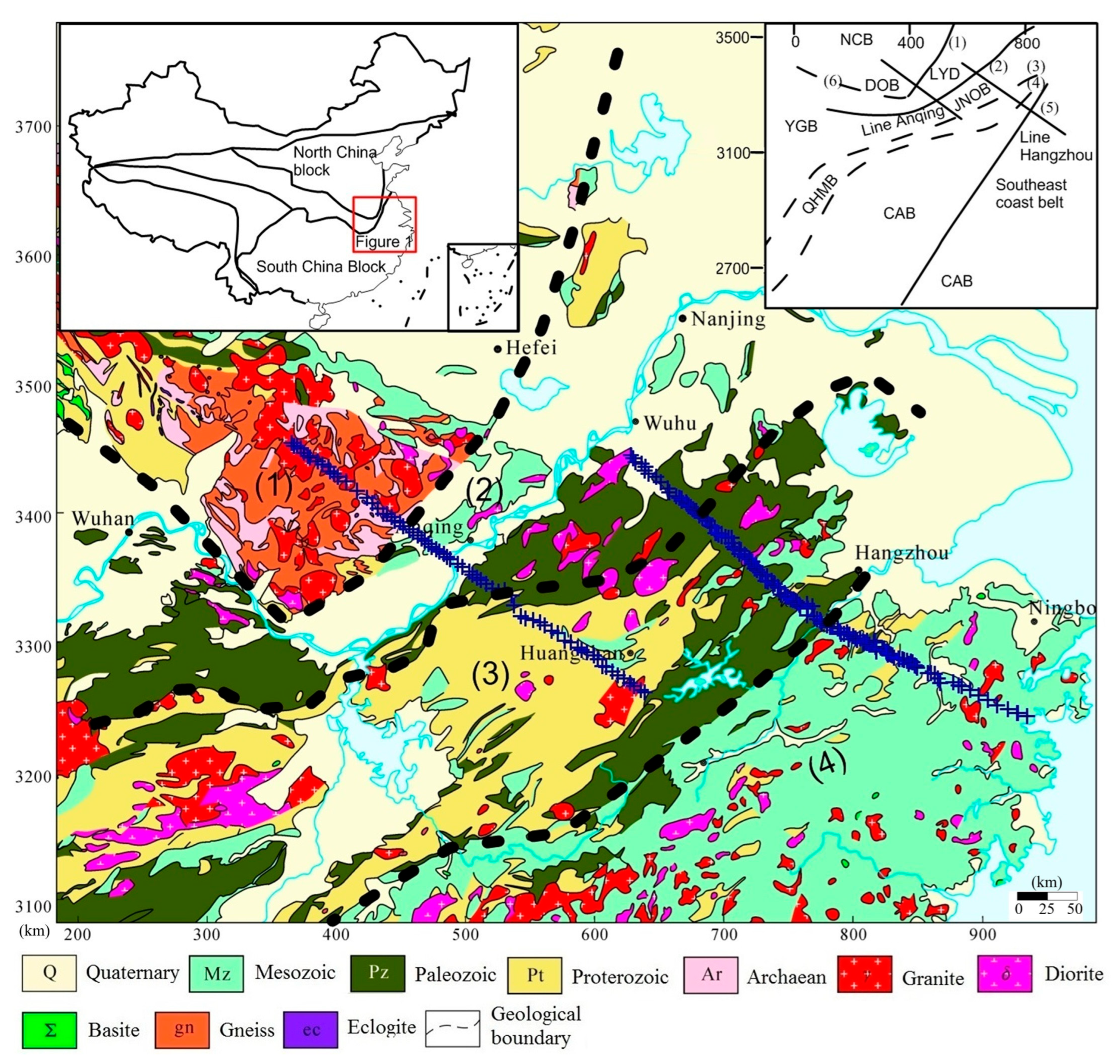
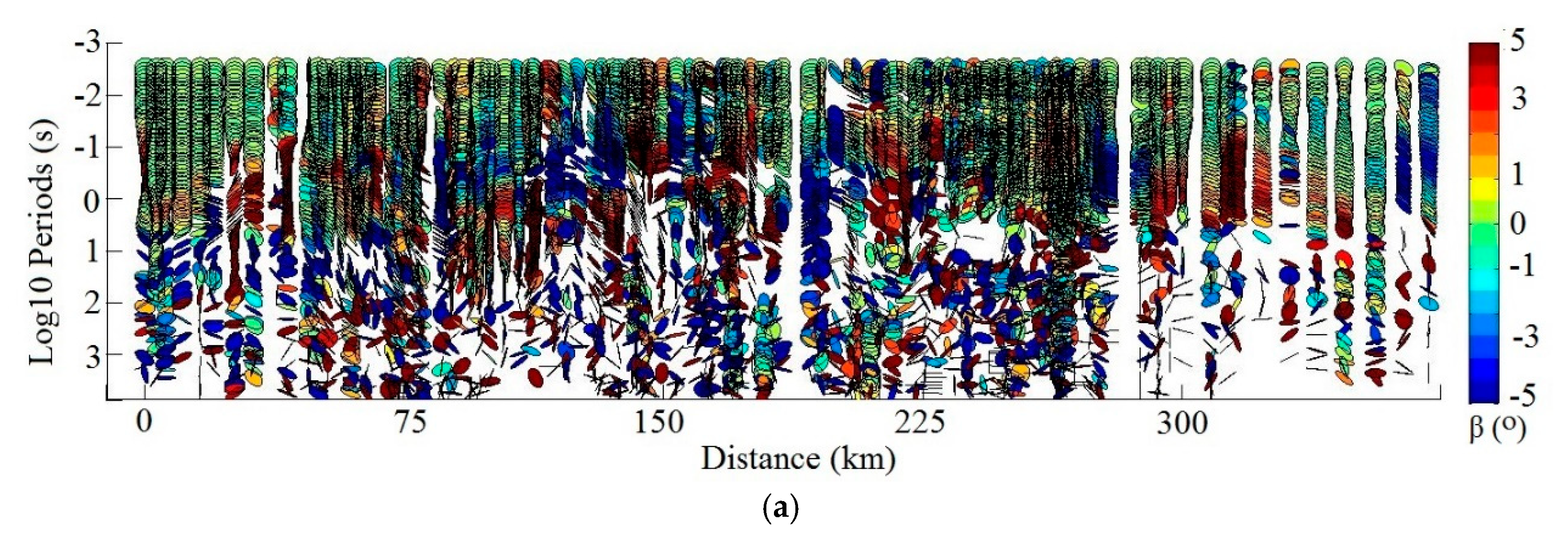
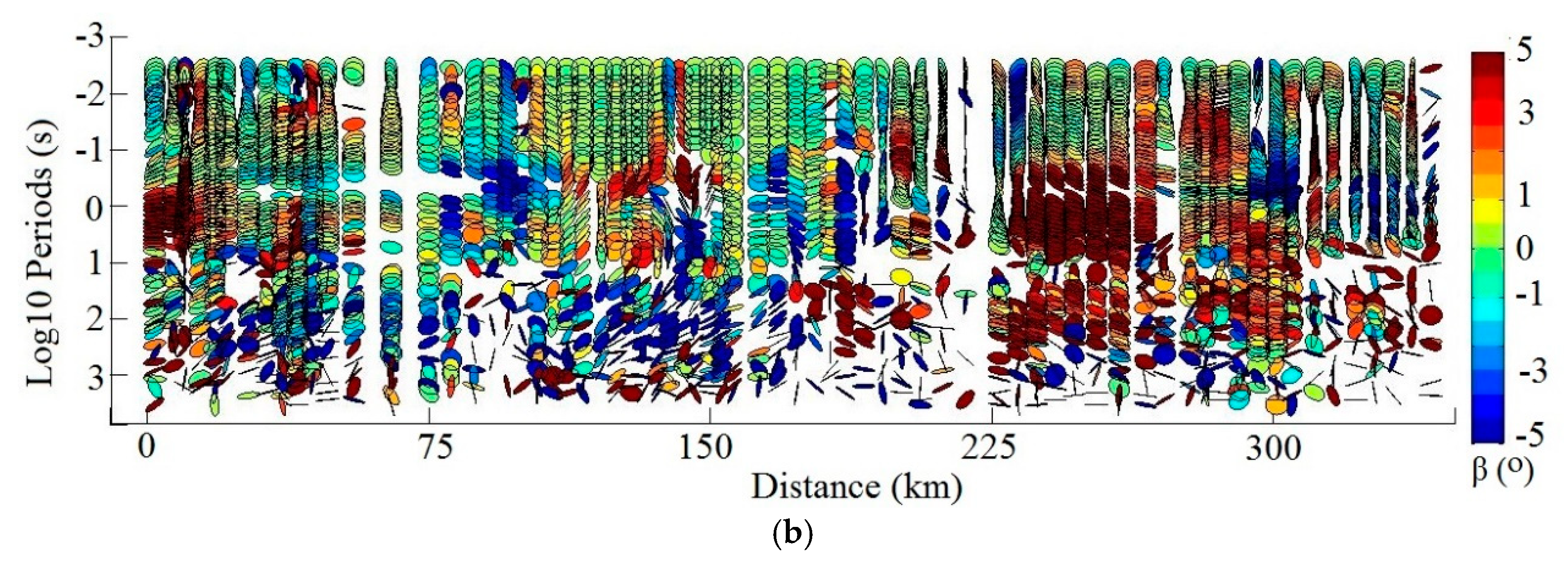


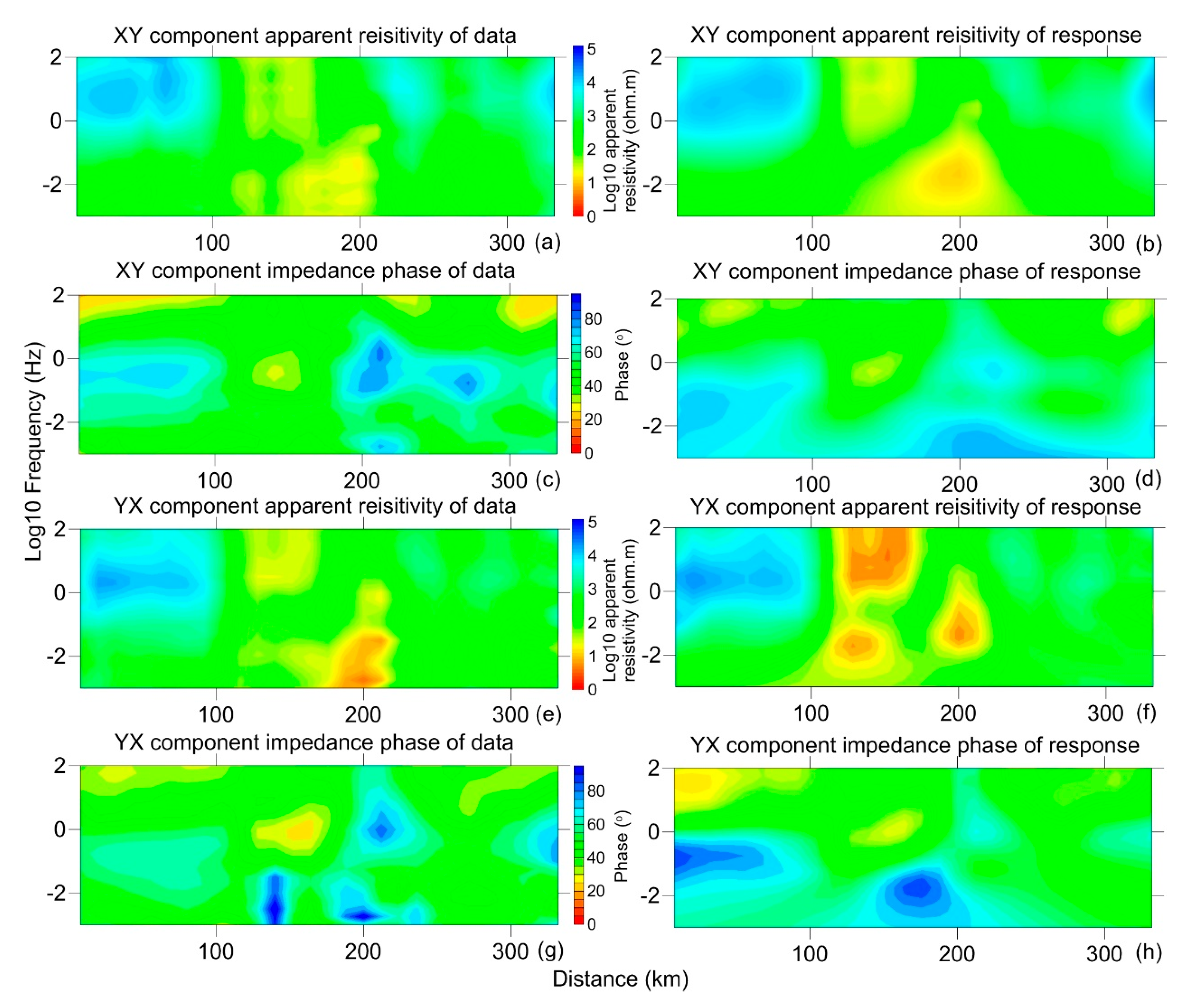


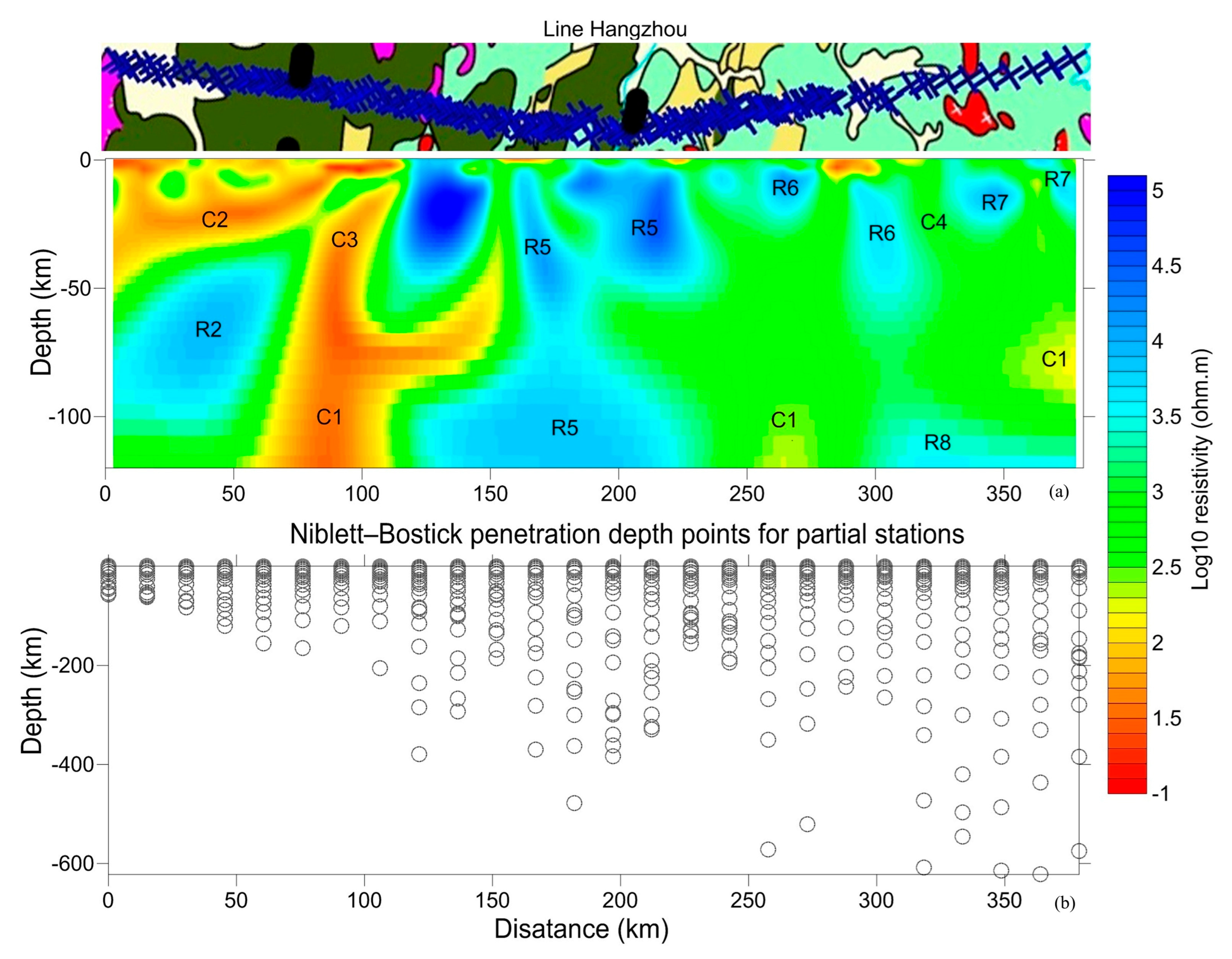
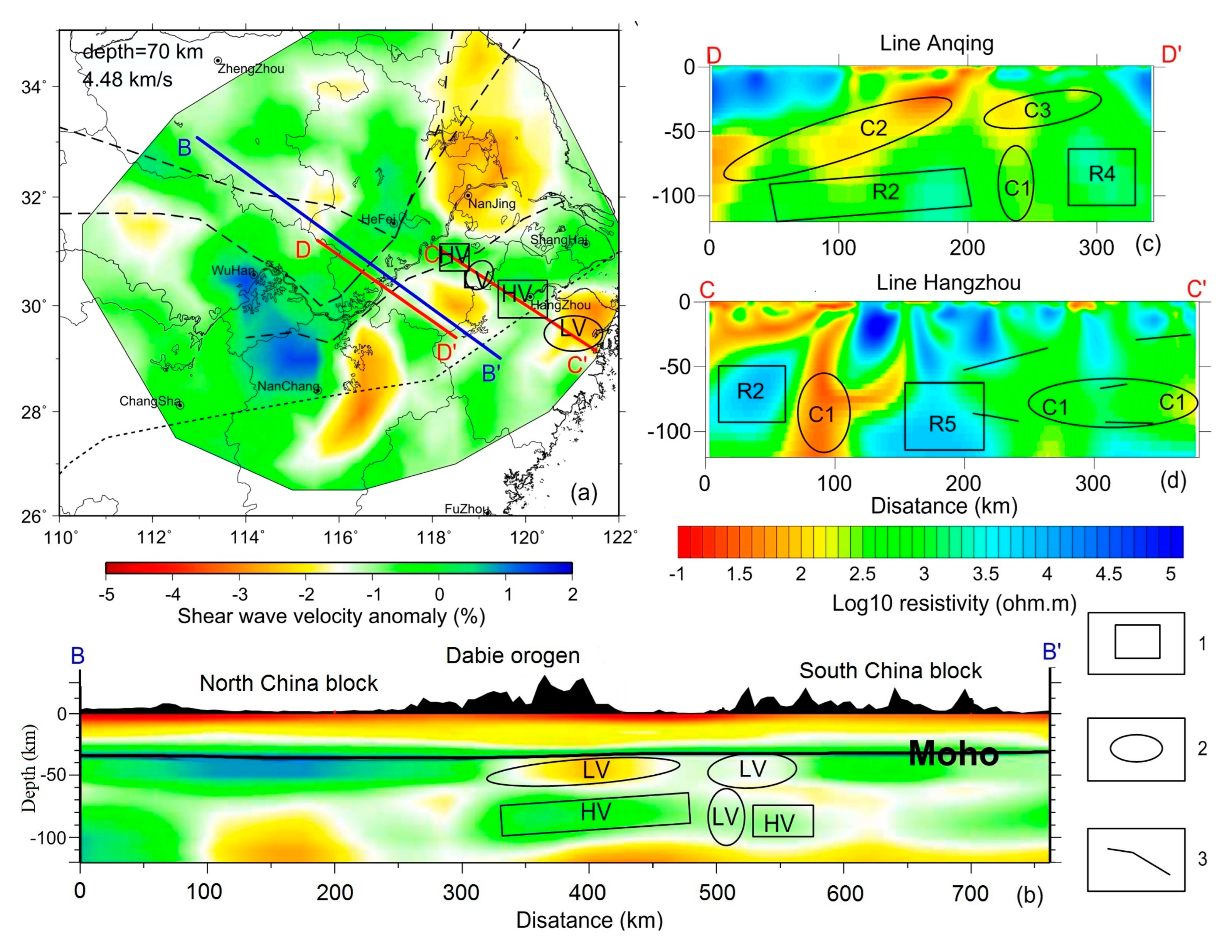
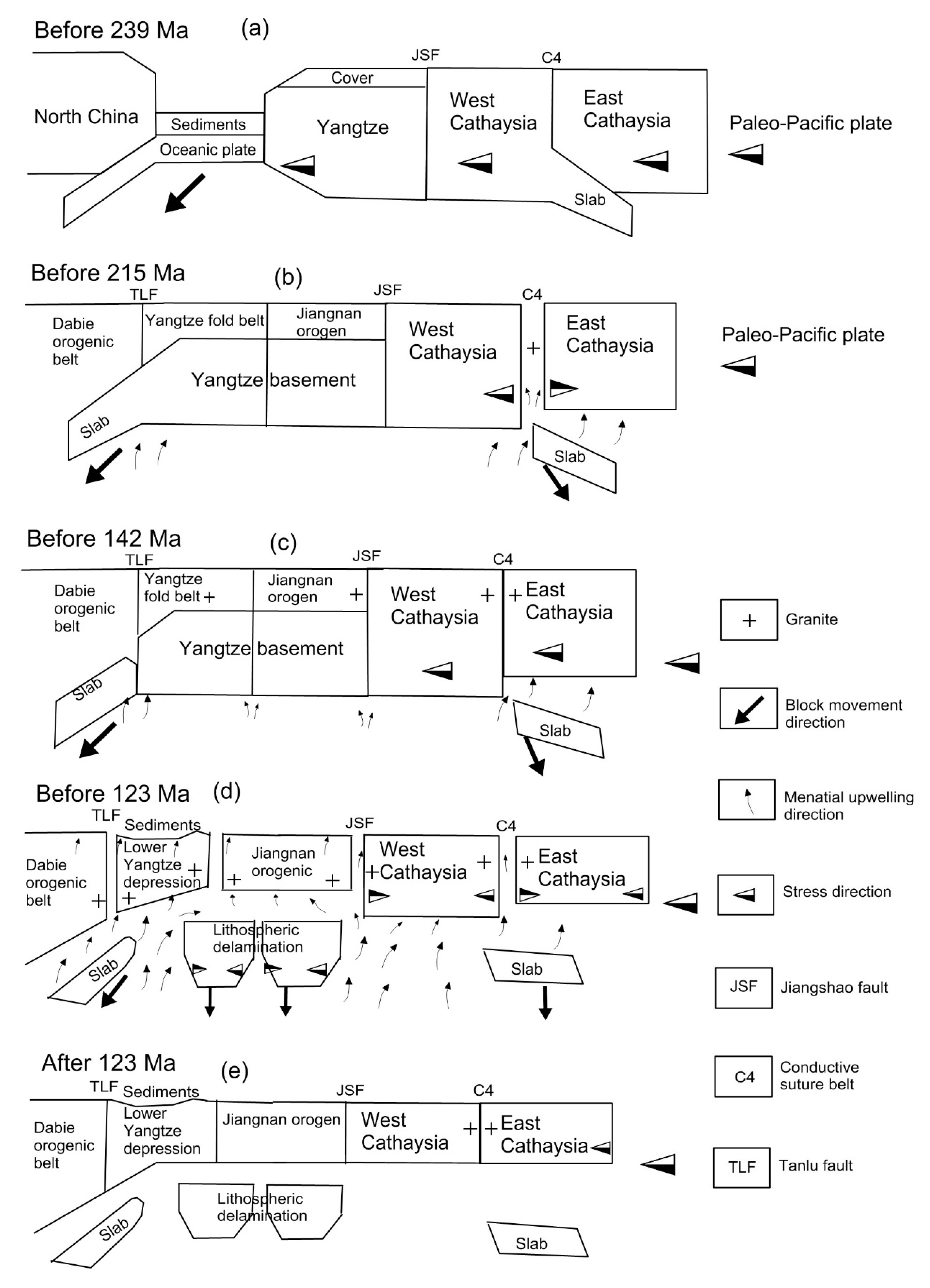
Disclaimer/Publisher’s Note: The statements, opinions and data contained in all publications are solely those of the individual author(s) and contributor(s) and not of MDPI and/or the editor(s). MDPI and/or the editor(s) disclaim responsibility for any injury to people or property resulting from any ideas, methods, instructions or products referred to in the content. |
© 2025 by the authors. Licensee MDPI, Basel, Switzerland. This article is an open access article distributed under the terms and conditions of the Creative Commons Attribution (CC BY) license (https://creativecommons.org/licenses/by/4.0/).
Share and Cite
Zhang, K.; Wan, Z.; Ma, X.; Yang, Y.; Hu, H. Electrical Imaging Across Eastern South China: New Insights into the Intracontinental Tectonic Process During Mesozoic. Minerals 2025, 15, 1035. https://doi.org/10.3390/min15101035
Zhang K, Wan Z, Ma X, Yang Y, Hu H. Electrical Imaging Across Eastern South China: New Insights into the Intracontinental Tectonic Process During Mesozoic. Minerals. 2025; 15(10):1035. https://doi.org/10.3390/min15101035
Chicago/Turabian StyleZhang, Kun, Zhaohong Wan, Xingzhi Ma, Yufan Yang, and Hao Hu. 2025. "Electrical Imaging Across Eastern South China: New Insights into the Intracontinental Tectonic Process During Mesozoic" Minerals 15, no. 10: 1035. https://doi.org/10.3390/min15101035
APA StyleZhang, K., Wan, Z., Ma, X., Yang, Y., & Hu, H. (2025). Electrical Imaging Across Eastern South China: New Insights into the Intracontinental Tectonic Process During Mesozoic. Minerals, 15(10), 1035. https://doi.org/10.3390/min15101035





